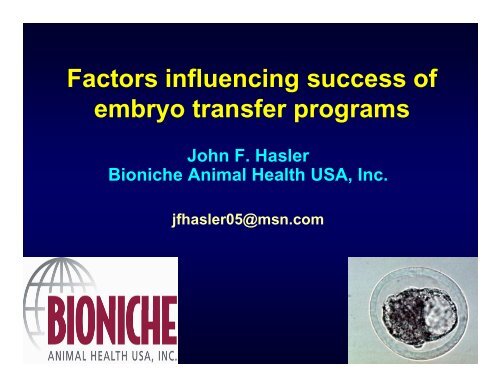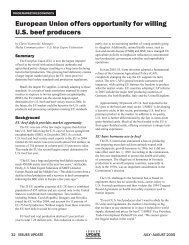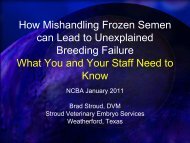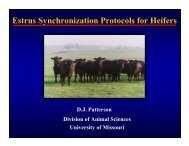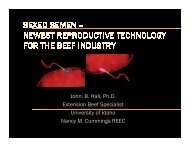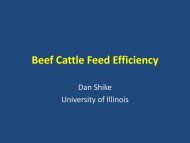Factors influencing success of embryo transfer programs
Factors influencing success of embryo transfer programs
Factors influencing success of embryo transfer programs
Create successful ePaper yourself
Turn your PDF publications into a flip-book with our unique Google optimized e-Paper software.
<strong>Factors</strong> <strong>influencing</strong> <strong>success</strong> <strong>of</strong><br />
<strong>embryo</strong> <strong>transfer</strong> <strong>programs</strong><br />
John F. Hasler<br />
Bioniche Animal Health USA, Inc.<br />
jfhasler05@msn.com
The goal <strong>of</strong> bovine <strong>embryo</strong> <strong>transfer</strong>
Some variables in <strong>embryo</strong> <strong>transfer</strong><br />
Donors<br />
Breed<br />
Parity<br />
Age<br />
Genetics<br />
Lactational status<br />
Reproductive history<br />
Nutrition<br />
Climate<br />
Season<br />
Superovulation<br />
gonadotropin<br />
dose<br />
route <strong>of</strong> injection<br />
frequency <strong>of</strong> inj.<br />
stage <strong>of</strong> cycle<br />
method <strong>of</strong> synchr.<br />
Insemination<br />
quality<br />
no. sperm<br />
Management system<br />
Stress<br />
Embryos<br />
Super vs. single<br />
Donor<br />
Breed<br />
Age<br />
Fertility<br />
Sire<br />
Size <strong>of</strong> response<br />
Age <strong>of</strong> <strong>embryo</strong><br />
Stage <strong>of</strong> <strong>embryo</strong><br />
Quality <strong>of</strong> <strong>embryo</strong><br />
Storage medium<br />
Length <strong>of</strong> storage<br />
Conditions <strong>of</strong> storage<br />
Fresh<br />
Frozen<br />
Split<br />
IVF<br />
Cloned<br />
Transgenic<br />
Recipients<br />
Breed<br />
Parity<br />
Age<br />
Lactational status<br />
Reprod. history<br />
Nutrition<br />
Climate<br />
Season<br />
Estrus induction<br />
Synchrony w. <strong>embryo</strong><br />
CL quality<br />
Side <strong>of</strong> <strong>transfer</strong><br />
Method <strong>of</strong> <strong>transfer</strong><br />
Site <strong>of</strong> <strong>transfer</strong><br />
Drugs/hormones<br />
Stress<br />
Practitioner<br />
Experience<br />
Skill<br />
‘Luck’
Gonadotrophin preparations used in commercial<br />
<strong>embryo</strong> <strong>transfer</strong> in the past 35 years
Number <strong>of</strong> bovine flushes and <strong>embryo</strong>s<br />
recovered yearly in the USA between<br />
2002 and 2008<br />
Year No. Flushes No. Embryos Mean no. Emb. / Flush<br />
2002 28,109 172,118 6.1<br />
2003 34,896 205,441 5.9<br />
2004 40,701 248,469 6.1<br />
2005 48,233 305,129 6.3<br />
2006 51,802 319,984 6.2<br />
2007 54,808 332,486 6.1<br />
2008 52,804 329,171 6.2<br />
(Compliments <strong>of</strong> the American Embryo Transfer Association)
Superovulation variability among beef<br />
cattle in Texas over time<br />
1986 2001<br />
No. collections 2,048 1,156<br />
Mean total ova 11.5 12.7<br />
Mean degenerates 2.2 2.4<br />
Mean <strong>embryo</strong>s 6.2 6.5<br />
Mean UFO 3.1 3.8<br />
(Looney, 2004)
Effect <strong>of</strong> cattle breed on superovulation<br />
Beef a No. supered Total ova Good <strong>embryo</strong>s % good<br />
Beefmaster 80 13.8 7.8 57<br />
Brangus 1290 12.0 6.4 53<br />
Brahma 144 8.9 5.6 63<br />
Simmental 141 10.5 6.5 62<br />
Dairy b<br />
Holstein 6787 11.6 6.2 53<br />
Ayrshire 332 14.8 7.4 50<br />
Brown Sw. 84 10.1 5.5 54<br />
Jersey 332 14.3 7.3 51<br />
( a Looney, 1986; b Sauvé, 2003)
Effect <strong>of</strong> age on superovulatory responses<br />
<strong>of</strong> 633 reproductively-healthy Holsteins<br />
Age group No. animals Mean no. ova<br />
Mean no. good<br />
<strong>embryo</strong>s<br />
Heifers 28 6.1 3.8<br />
2 – 6 years 308 10.4 6.7<br />
7 – 10 years 224 10.6 6.9<br />
11 – 14 years 64 9.7 5.3<br />
>15 years 9 5.6 2.6<br />
(Hasler, et al., 1983)
Variation in superovulation among 5<br />
individual Holstein cows<br />
No. Mean % % Mean no.<br />
Donor supers. total ova* unfert.* degen.* good*<br />
A 11 18.6 45 7 8.9<br />
B 13 12.2 26 31 5.2<br />
C 9 10.3 7 1 9.2<br />
D 15 8.7 10 14 6.3<br />
E 13 5.4 36 15 2.5<br />
*P
8<br />
Effect <strong>of</strong> day FSH started<br />
on superovulation<br />
No. <strong>transfer</strong>able <strong>embryo</strong>s<br />
7<br />
6<br />
5<br />
4<br />
3<br />
2<br />
1<br />
Donaldson<br />
Hasler<br />
McDonald<br />
Steel<br />
0<br />
6 7 8 9 10 11 12 13<br />
Day <strong>of</strong> cycle FSH started<br />
14<br />
Donaldson, n = 933 (beef); Hasler, n = 639 (dairy); McDonald, n = 3,724 (dairy);<br />
Steel, Donaldson, n = 2,340 n = (dairy)<br />
(Donaldson, 1984; Hasler et al., 1983; McDonald, unpub.; Steel, unpub.)
CIDR®<br />
(controlled intravaginal drug releasing device)
Superovulation protocol set-ups<br />
1<br />
Day 0* 1 2 3 4 10<br />
FSH FSH FSH FSH Heat Flush<br />
(AM & PM) (AM & PM) ( AM & PM) (AM & PM) (AM)<br />
PG<br />
(Am & PM)<br />
Heat<br />
(PM or D4 )<br />
(*Day 8-13 <strong>of</strong> cycle)<br />
2<br />
Day 0 4 5 6 7 9 16<br />
CIDR FSH FSH FSH FSH Heat Flush<br />
(AM & PM) (AM & PM) (AM & PM) (AM & PM)<br />
EB + P4<br />
PG<br />
(AM & PM)<br />
CIDR X<br />
(PM)<br />
3<br />
Day 0 2 4 5 6 7 8 9 16<br />
CIDR GnRH FSH FSH FSH FSH FSH Heat Flush<br />
(PM) (PM) (AM & PM) (AM & PM) (AM & PM) (AM)<br />
PG<br />
(PM)<br />
PG<br />
(AM)<br />
CIDR X<br />
(AM)<br />
GnRH
Superovulation Results<br />
(6 ET practitioners in 6 different states)<br />
Set-up No. donors Total ova Good <strong>embryo</strong>s<br />
1 16 16.0 9.1<br />
1 8 15.3 9.0<br />
1 12 8.2 4.1<br />
2 7 22.4 15.3<br />
2 10 11.0 2.9<br />
3 10 14.8 8.1
Reducing the number <strong>of</strong> injections<br />
involved in superovulation<br />
8 injections versus 2 injections <strong>of</strong> FSH<br />
Fewer trips through the chute =<br />
• savings in labor & expense<br />
• less stress on cattle<br />
• reduction <strong>of</strong> injury to personnel and cattle
Superovulation <strong>of</strong> beef cattle with two<br />
injections <strong>of</strong> Folltropin®FSH dissolved in<br />
a slow release formula (SRF) diluent<br />
Percent Pregnant<br />
18<br />
16<br />
14<br />
12<br />
10<br />
8<br />
6<br />
4<br />
a<br />
b<br />
b<br />
controls<br />
SRF 0.5%<br />
SRF 1.0%<br />
2<br />
0<br />
ova fertilized <strong>embryo</strong>s<br />
ab P
More <strong>embryo</strong>s per flush<br />
Have we improved this statistic in the<br />
past 35 years?
Yearly Mean Total Ova and Embryos from ~15,000<br />
Collections <strong>of</strong> Dairy cattle over a 20-Year Period<br />
Percent Pregnant<br />
15<br />
14<br />
13<br />
12<br />
11<br />
10<br />
9<br />
8<br />
7<br />
6<br />
5<br />
4<br />
3<br />
2<br />
1<br />
0<br />
Total Ova<br />
Embryos<br />
AETA<br />
CETA<br />
1985 1990 1995 2000 2005<br />
Change from FSH-P to Folltropin<br />
Year<br />
(Sauvé-unpublished)
Semen
Effect <strong>of</strong> AI interval post estrus on fertilization and<br />
the number <strong>of</strong> good <strong>embryo</strong>s recovered<br />
from superovulated cows<br />
AI Treatment a<br />
CL (Mean)<br />
% Ova<br />
fertilized<br />
% Transferable<br />
<strong>embryo</strong>s (Mean)<br />
12 h 10.0 72 b 61 b (4.7)<br />
24 h 12.8 79 b 66 b (6.7)<br />
36 h 13.0 54 b 30 c (3.0)<br />
48 h 8.1 19 c 1.7 d (0.2)<br />
12,24,36 & 48 h 10.0 77 b 61 b (3.7)<br />
a<br />
20 million sperm/straw, 2 straws per AI, 12 donors per group<br />
b,c,d P
Effect <strong>of</strong> 9 sires on fertilization rate and<br />
<strong>embryo</strong> production in 1596<br />
superovulated dairy cows<br />
% <strong>of</strong> total <strong>embryo</strong>s/UFO<br />
60<br />
50<br />
40<br />
30<br />
20<br />
10<br />
0<br />
% good <strong>embryo</strong>s<br />
% UFO<br />
1 2 3 4 5 6 7 8 9<br />
Sires used for AI<br />
(Compliments <strong>of</strong> MacDonald, unpublished)
Effect <strong>of</strong> semen quality on fertilization rate and<br />
<strong>embryo</strong> quality in superovulated cattle<br />
(227 bulls used in 742 donors)<br />
Semen % Fertilized % Excellent<br />
Quality* (n = 9,732) Embryos (n = 4,035)<br />
Excellent 82.1 a 61.2 a<br />
Good 67.7 b 55.7 b<br />
Fair 58.3 c 53.9 c<br />
Poor 51.8 d 33.7 d<br />
abcd P
Comparison <strong>of</strong> semen quality when shipped to ET<br />
center directly from commercial AI unit compared<br />
to semen provided by breeder client<br />
Source <strong>of</strong> semen<br />
Semen quality at thawing Direct from AI center Provided by client<br />
No. <strong>of</strong> shipments 1,278 981<br />
Poor quality semen (%) 22 (1.7 a ) 66 (6.7 b )<br />
Semen with no motility (%) 0 (0 a ) 24 (2.4 b )<br />
a,b Percentages in the same row differ significantly (P
Embryo Production <strong>of</strong> Superovulated Angus<br />
Cows Inseminated with Sexed Semen<br />
14<br />
12<br />
11.7<br />
12.0<br />
Conventional<br />
Sexed<br />
No. Embryos/Ova<br />
10<br />
8<br />
6<br />
4<br />
2<br />
6.5<br />
**<br />
4.5<br />
3.1<br />
6.3<br />
**<br />
2.0<br />
1.0<br />
0<br />
Total Transferable Unfertilized Degenerate<br />
** Treatments differ (P < 0.05) Category<br />
(32 cows per treatment inseminated at onset <strong>of</strong> heat and 12 (2X)<br />
& 24 h post. Control = 15M; Sexed = 2M)<br />
(Lamb et al., 2007)
Embryo <strong>Factors</strong>
Effect <strong>of</strong> bovine <strong>embryo</strong> grade (9,021 fresh<br />
& 5,287 frozen) on pregnancy rate<br />
Pregnant (%)<br />
80<br />
70<br />
60<br />
50<br />
40<br />
30<br />
20<br />
a<br />
a<br />
b<br />
b<br />
Fresh<br />
Frozen<br />
c c c b,c<br />
10<br />
0<br />
1 2 3 4<br />
Embryo Grade<br />
a,b,c<br />
Values differ (P
Cryopreservation<br />
Freezing Embryos
The number <strong>of</strong> bovine <strong>embryo</strong>s recovered,<br />
<strong>transfer</strong>red, and frozen in 2006 as reported by the<br />
AETA and the CETA<br />
AETA<br />
CETA<br />
No. donors collected 51,893 14,623<br />
No. <strong>embryo</strong>s<br />
recovered<br />
No. <strong>embryo</strong>s<br />
<strong>transfer</strong>red (%)<br />
319,703 96,285<br />
104,722 (32.8%) 24,727 (25.7%)<br />
No. <strong>embryo</strong>s frozen 207,871 (65.0%) 65,568 (68.1%)<br />
Glycerol<br />
Ethylene Glycol<br />
8,246 (4%)<br />
199,625 (96%)<br />
5,494 (21%)*<br />
20,458 (79%)<br />
(*No. thawed and <strong>transfer</strong>red in 2006)<br />
(Official statistics <strong>of</strong> the AETA and CETA)
Equipment Needed<br />
Glycerol (10 to 20 minutes)<br />
Warm water thaw container<br />
Trained Embryologist<br />
Microscope<br />
Sucrose solutions<br />
Holding medium<br />
Reload straw<br />
Ethylene Glycol (1 minute)<br />
Warm water thaw container
Embryo Recipient Cattle in Hungary, 1980
Drugs & hormones used in attempts to<br />
improve pregnancy rates following AI<br />
and/or ET<br />
• Progesterone<br />
• LH<br />
• hCG<br />
• eCG (PMSG)<br />
• GnRH<br />
• Clenbuterol (smooth muscle relaxant)<br />
• Ibupr<strong>of</strong>en (anti-inflammatory & anti-PG synthesis)<br />
• Banamine (Flunixin Meglumine) (anti-inflammatory and anti-PG<br />
release)<br />
• PG Receptor Competitive Antagonist (AL8810 or ‘Embryo Armor’)<br />
• Growth Hormone (Posilac)<br />
• Estradiol
Effect <strong>of</strong> <strong>embryo</strong>-recipient estrus synchrony on pregnancy<br />
rates in recipients <strong>of</strong> different breeds and parity (fresh &<br />
frozen <strong>embryo</strong>s)<br />
80<br />
75<br />
70<br />
% Pregnant<br />
65<br />
60<br />
55<br />
50<br />
45<br />
40<br />
35<br />
Dairy heifers: n= 10,108<br />
Beef cows: n= 1,256<br />
Dairy cows: n= 1,297<br />
30<br />
48 36 24 12 0 -12 -24 -36 -48<br />
(Plus) Synchrony (hours) (Minus) (Hasler, 2001)
Effect <strong>of</strong> recipient-donor estrus synchrony on<br />
pregnancy rate with fresh and frozen <strong>embryo</strong>s<br />
80<br />
75<br />
% Pregnant<br />
70<br />
65<br />
60<br />
55<br />
50<br />
45<br />
40<br />
35<br />
Fresh n= 8996<br />
Frozen n= 5271<br />
30<br />
48 36 24 12 0 -12 -24 -36 -48<br />
(Plus) Synchrony (hours) (Minus) (Hasler, 2001)
HEAT DETECTION<br />
1 Shot PG<br />
CIDR ® -PG<br />
MGA ® -PG<br />
MGA<br />
1 14<br />
FIXED-TIME AI (TAI)*<br />
CO-Synch + CIDR ®<br />
Perform TAI at 54 ± 2 hr after PG with GnRH at TAI.<br />
MGA ® -PG<br />
GnRH<br />
Perform TAI at 72 ± 2 hr after PG with GnRH at TAI.<br />
MGA<br />
1 14<br />
CIDR ® Select<br />
BEEF HEIFER PROTOCOLS<br />
HEAT DETECT & TIME AI (TAI)<br />
PG<br />
0 5<br />
12<br />
treatment day<br />
Heat detect & AI<br />
… 19 d …<br />
treatment day<br />
CIDR ®<br />
PG<br />
0 7<br />
treatment day<br />
… 19 d …<br />
treatment day<br />
Perform TAI at 72 ± 2 hr after PG with GnRH at TAI.<br />
CIDR ®<br />
0 7 13<br />
Heat detect & AI<br />
treatment day<br />
PG<br />
PG<br />
33 39<br />
Heat detect & AI<br />
.. 54 ± 2 hr ..<br />
GnRH<br />
AI<br />
9<br />
GnRH<br />
PG<br />
AI<br />
72 ± 2 hr<br />
33 36<br />
GnRH<br />
Select Synch + CIDR ® & TAI<br />
Heat detect and AI day 7 to 10 and TAI all non-responders 72 - 84 hr after PG<br />
with GnRH at TAI.<br />
MGA ® -PG & TAI<br />
MGA<br />
1 14<br />
GnRH<br />
AI<br />
CIDR ®<br />
.. 72 - 84 hr ..<br />
0<br />
treatment day<br />
7<br />
10<br />
Heat detect & AI<br />
Heat detect and AI day 33 to 36 and TAI all non-responders 72 - 84 hrs after PG<br />
with GnRH at TAI.<br />
COMPARISON OF PROTOCOLS FOR BEEF HEIFERS<br />
PG<br />
GnRH<br />
GnRH<br />
PG<br />
AI<br />
.. 72 - 84 hr ..<br />
33<br />
36<br />
Heat detect & AI<br />
HEAT DETECTION COST LABOR<br />
1 Shot PG Low High<br />
CIDR ® -PG Medium Medium<br />
MGA ® -PG Low Low/Medium<br />
HEAT DETECT & TAI<br />
Select Synch + CIDR ®<br />
(TAI nonresponders<br />
72-84 hr after PG)<br />
High Medium<br />
MGA ® -PG (TAI nonresponders<br />
72-84 hr after PG)<br />
Medium Medium<br />
FIXED-TIME AI (TAI)<br />
CO-Synch + CIDR ®<br />
(TAI 54 ± 2 hr after PG<br />
High Medium<br />
with GnRH at TAI)<br />
… 19 d …<br />
treatment day<br />
MGA ® -PG (TAI 72 ± 2 hr after PG<br />
with GnRH at TAI)<br />
Medium<br />
Medium<br />
CIDR<br />
0 14<br />
GnRH<br />
... 9d … .. 7d ..<br />
23<br />
treatment day<br />
PG<br />
AI<br />
GnRH CIDR ® Select<br />
(TAI 72 ± 2 hr after<br />
72 ± 2 hr<br />
Cystorelin ® , Factrel ® , Fertagyl ® , OvaCyst ® High Medium/High<br />
PG with GnRH at TAI)<br />
30 33<br />
Estrumate ® , In-Synch ® , Lutalyse ® , ProstaMate ® ,<br />
PG<br />
• The times estroPLAN listed for “Fixed-time ® AI” should be considered as the approximate average time <strong>of</strong><br />
insemination. This should be based on the number <strong>of</strong> heifers to inseminate, labor, and facilities.<br />
Beef Reproduction Task Force
Synchronization and Management <strong>of</strong> Recipients<br />
Heat<br />
Detection<br />
GnRH<br />
C I D R<br />
PGF 2<br />
α<br />
Heat<br />
check<br />
7 d<br />
( ± 1.5 d)<br />
T<br />
R<br />
A<br />
N<br />
S<br />
F<br />
E<br />
R<br />
Day 0 Day 7<br />
Day 16<br />
Timed<br />
Transfers<br />
GnRH<br />
C I D R<br />
PGF 2<br />
α<br />
No Heat<br />
Detection<br />
48 hr<br />
GnRH<br />
7 d<br />
T<br />
R<br />
A<br />
N<br />
S<br />
F<br />
E<br />
R<br />
Courtesy <strong>of</strong> Randall Hinshaw
Conception rates following <strong>embryo</strong> <strong>transfer</strong> in<br />
anestrus vs. cycling recipient beef cows<br />
Cow status 1<br />
No.<br />
received<br />
CIDR<br />
No. estrus<br />
detected (%)<br />
No.<br />
received<br />
<strong>embryo</strong> (%) 2<br />
No.<br />
Pregnant<br />
(%) 2<br />
Anestrus 321 161 (50.1) a 140 (87.0) 56 (40.0) a<br />
Cycling 376 338 (89.9) b 311 (92.0) 206 (66.2) b<br />
1 Status determined by palpation per rectum and ultrasound at time <strong>of</strong> CIDR<br />
insertion; 2 Percentages based on previous column.<br />
a,b P
Beef cattle on pasture<br />
Polled Herefords in Oklahoma, 2004
Commercial Dairy<br />
Holsteins in New Mexico, 2004
Embryo <strong>transfer</strong> outcomes in two<br />
different management systems<br />
Factor Beef ranch Commercial dairy<br />
No. donors 45 36<br />
No. superovulated &<br />
94 87<br />
inseminated<br />
Mean no. ova 14.4 9.1<br />
Mean no. unfertilized<br />
(% <strong>of</strong> total)<br />
Mean no. <strong>transfer</strong>able<br />
<strong>embryo</strong>s (% <strong>of</strong> total)<br />
3.1 (21.5) 4.3 (47.6)<br />
9.1 (63.2) 3.4 (37.7)<br />
ET recipient pregnancy<br />
rate<br />
>70%
‘The practitioner effect’
ET conception rates <strong>of</strong> IVP <strong>embryo</strong>s in the<br />
Netherlands relative to the day <strong>of</strong> the week on which<br />
<strong>transfer</strong>s were conducted<br />
Day <strong>of</strong> week No. trans. % pregnant<br />
Tuesday 633 50.8<br />
Friday 1103 42.2<br />
(Van Wagtendonk-de Leeuw et al., 1997)
Effect <strong>of</strong> technician on pregnancy rate <strong>of</strong><br />
13,485 IVP <strong>embryo</strong>s in Brazil<br />
Percent Pregnant<br />
50<br />
45<br />
40<br />
35<br />
30<br />
25<br />
20<br />
15<br />
10<br />
5<br />
0<br />
1 3 5 7 9 11 13 15 17 19 21 23<br />
Embryo Transfer Technician<br />
(Minimum <strong>of</strong> 200 <strong>transfer</strong>s per technician)<br />
(Technician no. 1 = 1 pregnant <strong>of</strong> 251 <strong>transfer</strong>s) Lamb, et al., 2005
Influence <strong>of</strong> technicians (n=12) on conception<br />
rates in AI (>6,000 inseminations in Holland)<br />
Note: There was a highly significant (P
“Luck”<br />
Probabilities <strong>of</strong> <strong>success</strong> resulting from the <strong>transfer</strong> <strong>of</strong><br />
four <strong>embryo</strong>s if the true conception rate is 50%<br />
No. Pregnant Average frequency Frequency %<br />
0/4 1/16 6<br />
1/4 1/4 25<br />
2/4 3/8 38<br />
3/4 1/4 25<br />
4/4 1/16 6<br />
(Seidel et al., 2003)
Key to Success<br />
If ET is conducted within reasonably<br />
acceptable parameters involving<br />
practitioner competence, media, <strong>embryo</strong><br />
quality, hygiene, etc., almost certainly the<br />
biggest factors affecting <strong>success</strong> are<br />
DONOR & RECIPIENT QUALITY &<br />
MANAGEMENT


